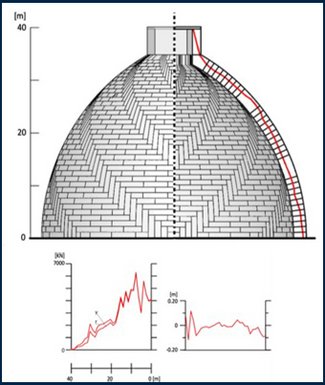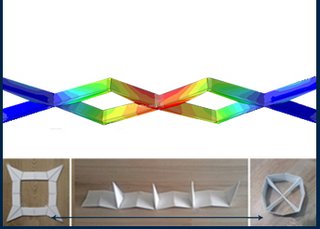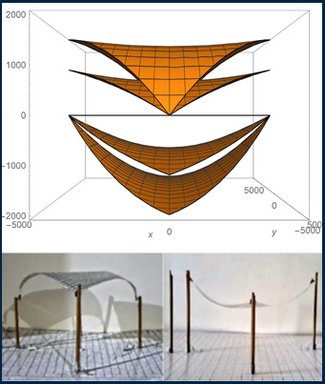How can we shape structures so that they fit current and foreseen design problems?
The innovative structural design research group is a design-oriented, experimental research lab that explores the role of structural geometries in relationship to the external loads and the other design agents under the aim to foster a digital tectonic culture of sustainable, adaptable and adaptive solutions.
It builds upon advanced manufacturing techniques to set modular elements whose geometry is customized up to the scale of the contact interface and of engineered materials, specifically in prefabricated modular structures, kinetimatics in modular systems and assembly operations, and novel dry block assembly structures.
It develops form-finding, optimization, and controlled morphing algorithms for performative structures, which employs data from in -situ sensors to adapt to variable and often uncertain working conditions.
Keywords
Tectonic design process; Generative structural design and optimization; Masonry structures; Geometry of structural materials; Kinetic structures; Lightweight structures; Digital tectonics
Possible case studies for students in research
Adaptable structures and components; Kinetic structures; Linkages and applications; Origami, and kirigami inspired modular structures and elements; Facade engineering; Customizable prefabrication of modular buildings; NSCD assessment and design of dry masonry structures;

Aita, D., Valentina, B., Garavaglia, E., Vittorio, P., Pizzigoni, A., & Sgambi, L. (2023). Stone reciprocal structures: suggestions from ancient Greece. In IASS Symposium 2023 Integration of Design and Fabrication July 10–14, 2023, Melbourne, Australia (Technical Program).
Pizzigoni, A., Paris, V., & Beatini, V. (2022, September). Why collapsed Ancient Hellenic Temples? The case study: Athena Pronaia Tholos at Delphi. In Proceedings of IASS Annual Symposia (Vol. 2022, No. 10, pp. 1-10). International Association for Shell and Spatial Structures (IASS).
Pizzigoni, A., Beatini, V., & Paris, V. (2022). The Stone Roof Marble Tholos Tiles in the Sanctuary of Athena Pronaia at Delphi. Stereotomy and compression resistant forms in the domed roof structures of ancient Greece. STRUCTURAL, 240(art. n. 8), 1-30.
Beatini V, Royer-Carfagni G, Tasora A, 2019. A non-smooth dynamic analysis of Brunelleschi’s cupola. An octagonal vault or a circular dome? Meccanica, 54:525–547. J13
Beatini V, Royer-Carfagni G, Tasora A, 2019, Modelling the shear failure of segmental arches. ijss
Beatini V, Royer-Carfagni G, Tasora A, 2018. The role of frictional contact of constituent blocks on the stability of masonry domes. Royal Society Proc. A 474 (2209)
Beatini V, Royer-Carfagni G, Tasora A, 2017. A regularized Non-Smooth Contact Dynamics approach for architectural masonry structures. Computer and Structures 187: 88–100
Beatini V, Royer Carfagni G. 2016. Large transformations of tensile membrane structures with moderate strains. Mathematics and Mechanics of Solids, 28, 1717 – 1737.
Emergency and modular housing

Beatini V, 2017. Symmetry-based Transformable and Foldable Plate Structures. J. of Mechanical Design 139(7): 072301-072313.
Beatini, V., 2016. Kinetic rosette patterns and tessellations. Int. J. of Comp.Methods & Experimental Measurements, WIT Transactions, 5(4): 631 - 641 ISSN:2046-0546 DOI: 10.2495/CMEM-V5-N4-631-641
Beatini V, 2015. Translational method for designing folded plates structures. Int. J.of Space Structures, 30(2).
Beatini V. 2015. Polar method to design folded plates structures. J. of the IASS, 2015, 56(84):125-137.
Beatini V, and Korkmaz K. 2014. Shapes of Miura mesh mechanism with mobility one. Int. J.of Space Structures, 28(2).
Beatini V, and Korkmaz K, 2013. A rib shaped kinetic folded plate structure. In: Escrig F., Sanchez J. (eds.), New Proposals for Transformable Architecture, Engineering and Design. Seville:Starbooks. ISBN: 978-84-939565-3-0

Beatini V, Royer Carfagni G. 2017. Soap film analogy for optimal transformable cable nets. Structural and Multidisciplinary Optimization, 55(3): 885-898.
Beatini V, Royer Carfagni G. 2016. Large transformations of tensile membrane structures with moderate strains. Mathematics and Mechanics of Solids, 28, 1717 – 1737.
Beatini V, Royer Carfagni G. 2013. Cable-stiffened foldable elastica for movable structures, Engineering Structures, 56, pp 126-136.
Beatini V, and Korkmaz K, 2013. A transformable tensile structure. Tensinet Symposium - [Re] Thinking lightweight structures, Istanbul.
Beatini V, 2013. Elastica for Transformable Architecture, ETA, and its use for tensioned membranes. Tensinet Symposium - [Re] Thinking lightweight structures, Istanbul.